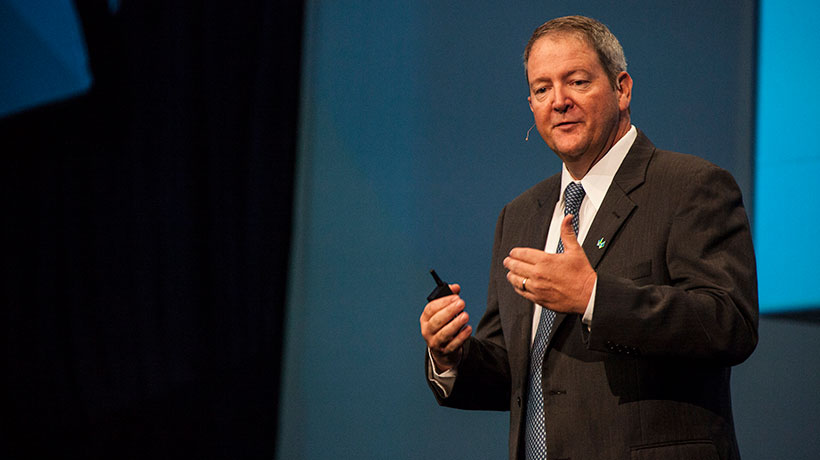The September 11, 2001, attack on the World Trade Center sets the stage for Hexagon Safety & Infrastructure President Steven Cost’s keynote address. Titled, “Safe Cities: From Concept to Reality,” Cost opens his keynote by talking to World Trade Center survivor Deputy Chief Jay Jonas, who gives his personal experience of rescuing people in the north tower, only to be rescued after the tower collapsed on him and other first responders.
As Cost and Jonas talk, it becomes clear that major incidents are not only stressful for first responders; but they also put a lot of stress on the information and communication systems agencies use to respond to and manage such events. At this point, Cost starts his dialogue with the audience, many of whom are leaders from public safety agencies, utilities and communications companies, and other government agencies from around the world.
Cost points to the fact that as urban populations continue to grow at projected rates, managing and overcoming urban safety challenges will remain top of mind for many city leaders, agencies, and citizens. He also talks about the increased focus of converging city functions, including multi-agency coordination, regionalization, and collaboration of first responders with second and third-tier agencies. Then, he begins to layout Hexagon Safety & Infrastructure vision for Safe Cities.
At the heart of Hexagon Safety & Infrastructure’s Safe Cities vision is an enterprise information architecture approach that integrates city organizations, their data, and their technology stacks. Cost then delves deeper into what he calls the four fundamentals of Safe Cities: connectivity, collaboration, intelligence, and accountability.
For the first fundamental, Cost discusses how connectivity is key for emergency service systems to communicate with other critical city systems like traffic, utilities, weather. Cost highlights three customers that leverage Hexagon cloud and web-based technologies to improve connectivity: Bell Canada, Bayernwerk, and Uttar Pradesh Police.
For collaboration, Cost talks about how the interconnectivity of technology brings emergency service agencies together with other government and business organizations, making it easier to work together toward the same goals. He discusses the recent launches of Intergraph Planning & Response, an application for managing major incidents and events, and Intergraph OnCall Dispatcher for I/CAD, are helping agencies coordinate resources and collaborate in new ways. During the collaboration section of the keynote, Cost also talks about OnDuty,the partnership effort between Hexagon Safety & Infrastructure and New Zealand Police. OnDuty provides the agency’s officers with real-time intelligence on their smartphones. Cost uses this part of the discussion to segue into the third fundamental of safe cities: intelligence.
In speaking about intelligence, Costs discusses the importance of leveraging collected data and information for better and more informed decision-making. At a high level, he talks about the new Intergraph InSight suite of solutions, and then focuses his attention to the intelligence that autonomous and mobile sensor platforms (e.g., UAVs and robots) can add to the full information picture. He highlights how Briggs & Stratton, a Fortune 1000 manufacturer, needed to keep its facilities secure, and became an early adopter of HxGN SMART Command – a cloud-based safety and monitoring software – and RAMSEE, Gamma 2 Robotics’ security patrol robot.
The fourth, and last, safe city fundamental is accountability. It’s really about using Hexagon Safety & Infrastructure’s solutions to improve transparency and auditability with regard to operational procedures and budgetary spending. Accountability is about being a good steward of taxpayers’ dollars and improving service quality while responding to changing political and social pressures and expectations. Cost also talks about the tragic shooting at Fort Hood, Texas, which led the U.S. Marine Corps System Command to implement Hexagon’s Intergraph Computer-Aided Dispatch system.
For Hexagon Safety & Infrastructure, helping its customers realize safer cities is not a feat it can achieve on its own. It takes strategic partnerships with system integrators across the globe, including Huawei, Mahindra Special Services Group, General Dynamics Mission Systems, Larsen & Tourbro, THALES, Microsoft, and Airbus. Partnerships like these help Hexagon Safety & Infrastructure address the complex needs associated with making cities safer.
Cost closes his keynote address by saying, “Working together, we can shape potential in cities around the globe to make them more connected and streamlined, more prepared and ready, smarter, and safer.”
Watch Steven Cost’s keynote in its entirety on HxGN TV. And don’t forget to watch Hexagon Safety & Infrastructure’s Chief Technology Officer, Kalyn Sims, and Senior Vice President of Global Product Development, Dan Retzer, deliver their HxGN LIVE keynote titled, “Convergence in the Cloud.” It will be broadcast live tomorrow at 10:00 a.m. PDT on Hexagon Safety & Infrastructure’s Facebook page and on HxGN TV.
















